This "How I Made That" post shows how this fire & flames skating dress came together, from sketch, to pattern, to crystalling.

Heads up: because I wasn’t shooting this with the intent of doing a blog, I don’t have photos of EVERY step, but there should definitely be enough to explain things pretty well.
Anyway, let’s get to it!
The Fire Skating Dress
Design
This dress is one that I designed in 1997-ish, as a competition dress for myself. I was planning to skate to The Firebird Suite.
... Then I got in a car accident, ruined my back, and was told I would never skate again.
So, the dress never got worn.

My very old, very poorly drawn original design sketch.
Flash forward to 2019. I was skating again, I was working towards competing again, and it was time to make some sample dresses for my costuming booths.
I was a LONG WAY off from being able to do a Firebird program justice, but the design was still on my mind... so I decided to remake the dress, as a sample size.
Originally, this dress was hand beaded and sequined.
As I mentioned in my “How to Make Sequins & Spangles” post... that’s not so much of a thing anymore, so the updated version would be crystalled.
Note: See my “Everything You Need to Know about Rhinestones” post for... well, everything you need to know about rhinestones!
The Fabric
I decided to stay with the shiny lycra style of the original dress, using #55 Black Shiny Tricot from Spandex House* as the base, with #24 Crimson Shiny Tricot and #15 Orange Shiny Tricot for the flame appliques.
The overskirt was also the shiny black tricot, with a layer each of #24 Crimson Sheer Mesh and #15 Orange Sheer Mesh.
It’s on a base of beige lining, and #03 Natural Stretch Mesh.
* A note on Spandex House: People in the costuming community have reported credit card issues, when using Spandex House's website. I have not, but I also call all my orders in to Edward. Given the reports of web/CC security issues, I definitely recommend phoning your order in!
Patterning the Skating Dress
Once I had my base pattern drafted to size (Basic Pattern Alterations) and cut out of exam table paper, I drew the applique design on what would become my master pattern:
I started with the front design, in pen. Once I was happy with the design lines, I went over them with a thin marker black marker, as shown.
Then I drew the design onto one of the 2 back pieces, being careful to match lines with the front design.
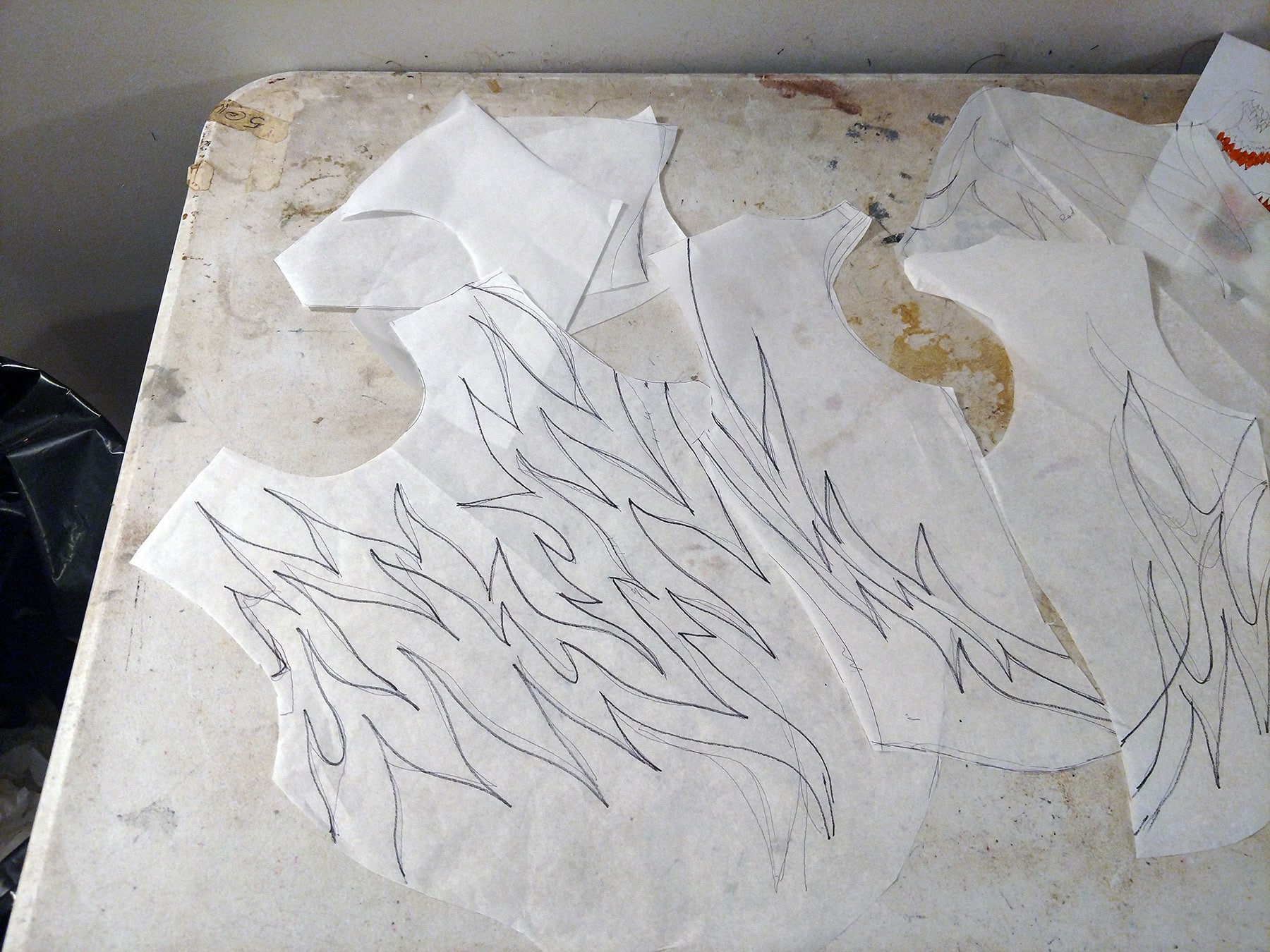
Note: As I mentioned in my last “How I Made That” post... don’t match your lines up, edge to edge.
If you hold your pattern sides together - unless a design element is going perfectly straight across - if they line up at the edge, they won’t line up when sewn.
Instead, you want to line up the design elements at the seam allowance line.
That is to say, while the design will continue right to the edge of the piece it’s being sewn to, it should be positioned to match the adjoining piece *with the seam allowances folded back*.
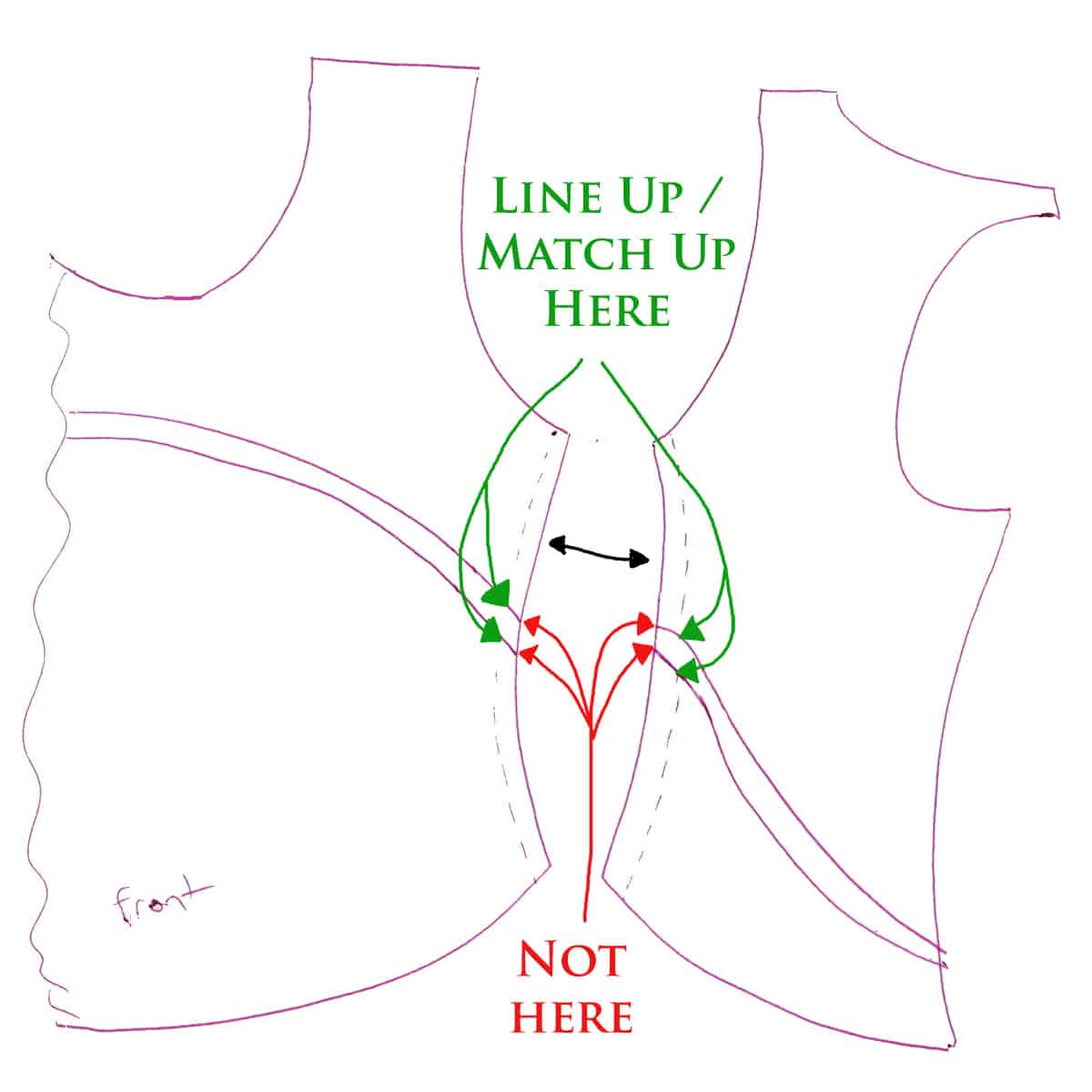
Really quick sketch - I'm not an artist, don't judge! LOL.
Once I’ve got one of the back pieces done, I start on the second one.
Once again, I took care to match up the design elements with both the first half of the back (at the center back seam), as well as at the side seam (with the front piece).
Labelling the Pattern Pieces
On this master pattern, I marked what each section represented - colour and type.
“Black spandex”, “Red Spandex”, and Orange Spandex”.
Sometimes I write the words out, sometimes I use codes - “BS, RS, OS”, for example - and sometimes I’ll just take coloured markers and draw a quick, colour-coded slash on each piece.
If you’re worried about losing track of where each piece goes, you can also add orientation arrows and/or piece designations.
Usually I’ll just add “front”, “left back”, and “right back”, though - on really complicated designs - sometimes I’ll number each piece.
At the very least, you’ll want some kind of marking so you know which side is the “good” side / right side.
Making the Final Pattern
Using more exam table paper, I’ll trace each section as separate, new patterns.
Beige lining was cut to the whole pattern size (the whole front bodice, 2x the back piece), as was the beige mesh.
When dealing with multiple appliques that line up with each other, I like to overlap slightly, stitching the top layer down onto the applique underneath it.
When choosing which goes on top, I decide based on which fabric will be less likely to show from under the other one.
In this case, the red is darker, and would be more likely to show from under the orange, than vice verse. So, Red on top, stitched down on the orange underneath.
This being the case, I added a small amount of “lip” to the edge of the orange applique that would go under the red.
I did the same on the black pieces, where they would go under the red.
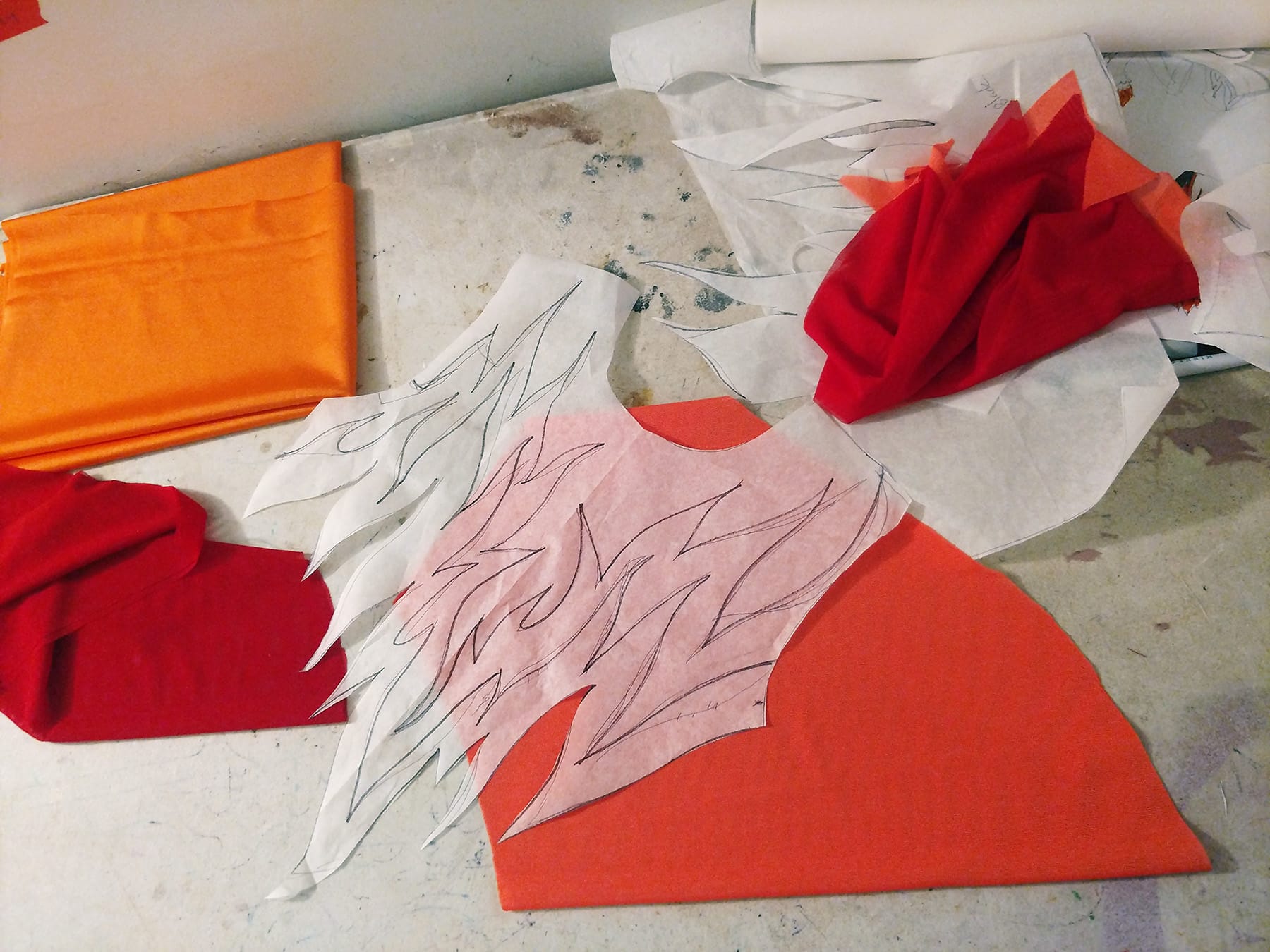
Cutting Your Fabric
Cutting the beige lining and mesh was straightforward.
Given the fussiness of the pieces, I used Odif's 505 Temporary Fabric Adhesive to make the patterns sticky.
As I described in my How to Cut Spandex post, gluing pattern pieces makes life a LOT easier.
Just be sure to spray the pattern sides that are “right side”, and place them face down on the wrong/back side of the fabric.
Then I cut them out and sorted them into 3 piles - front, left back, and right back.
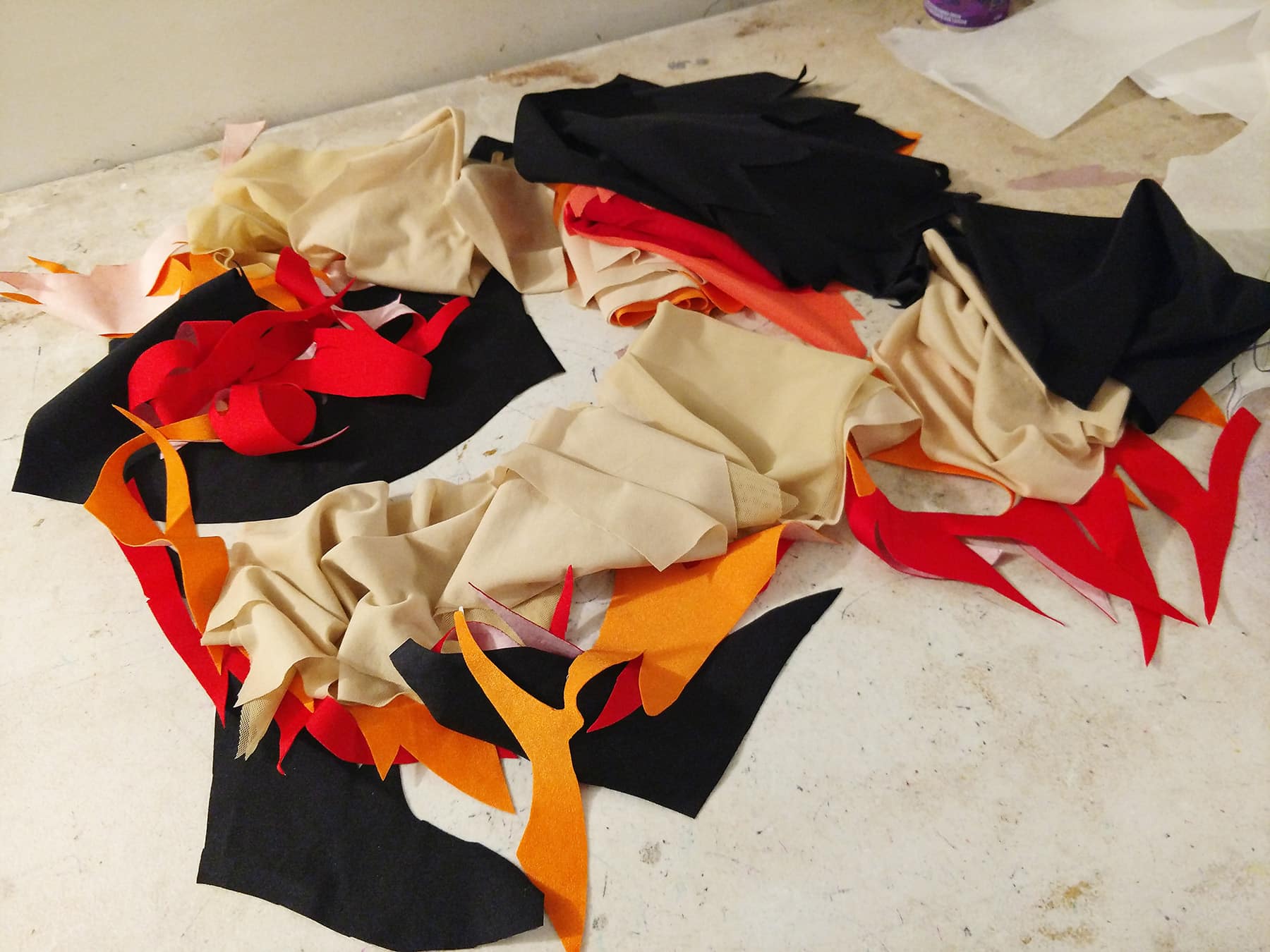
Piecing the Skating Dress
One main piece at a time, I glue everything together!
First, I hit the lining - right side up - with a bit of adhesive, and position the beige mesh for that part. This was for the front bodice, both back bodice pieces, and one sleeve.
When it came to the sleeve, theoretically I didn’t NEED to glue the mesh to the lining... but it really does make for easier handling.
That piece was set aside, as I wouldn’t need it til after all of the applique was done.
Then I sprayed the black pieces - right side down, so I’m spraying what will be the underside.
I positioned them on the lining/mesh, using the corresponding master pattern as a guide.
Once the black parts were in place, I glued the orange pieces down, and then the red on top of them
One handy thing about using the medical exam table paper is that it’s relatively easy to see through - so you can place it on top of your pieces, and see if they’re in the right spot or not.
Anyway, once I was happy with the positioning - and are positive that everything is right where it was supposed to be - I pinned everything into place.

Then, repeat everything with the remaining 2 main pieces, as well as the remaining sleeve.
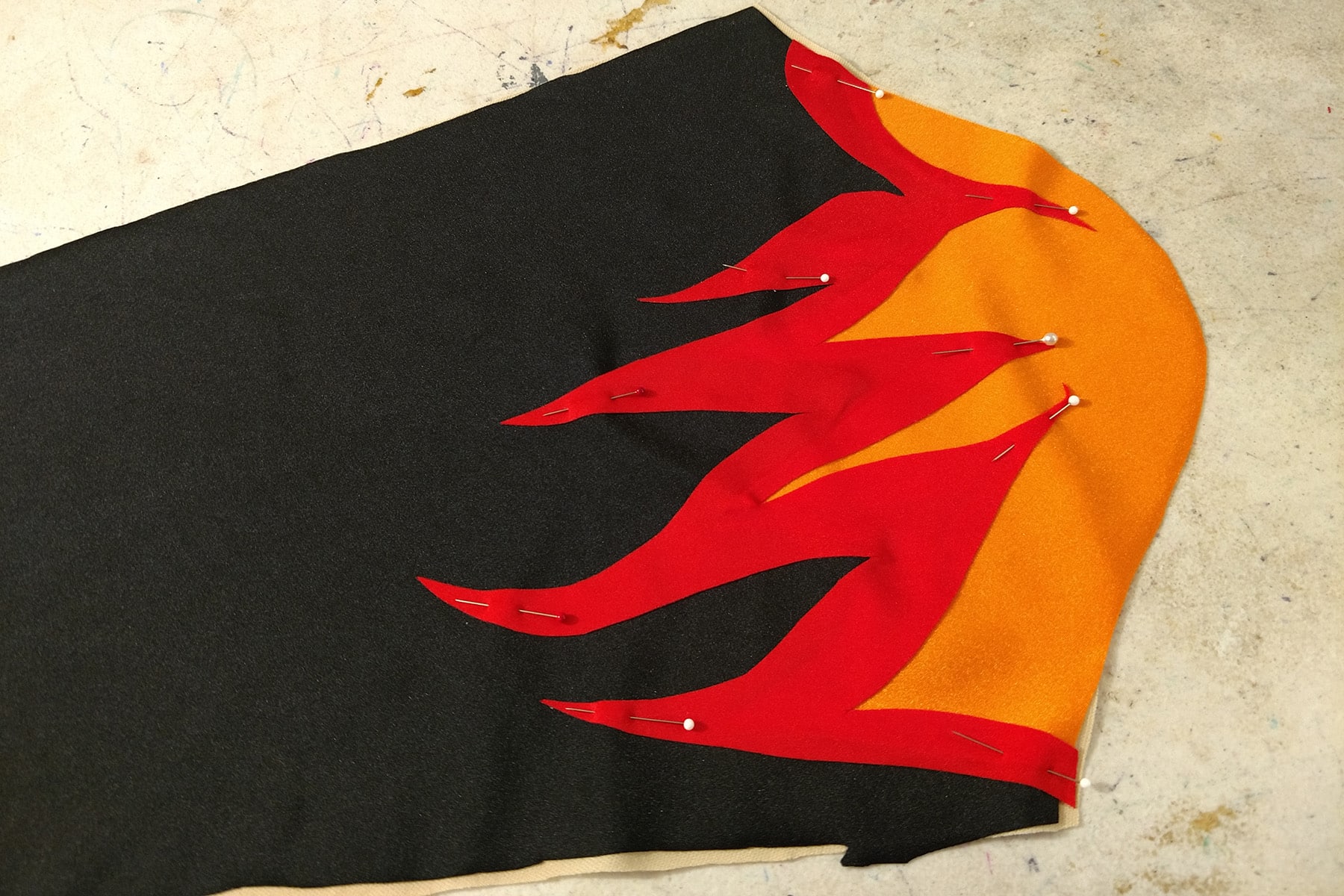
Applique the Design
I like to start with the colour that either represents the MOST of the applique, and/or the one that will contribute the most to structure / hold the most of the other pieces in place.
In this case, that was the red - as the red was appliqued, it would secure the black and orange pieces to the suit, leaving only the orange free edge left to be stitched down.
So, I loaded up my sewing machine with red thread (I like Gutterman and Mettler brands), and appliqued all of the red edges on all 4 pieces.
Note: See my How to Applique Spandex post for full details on how I applique.
Then, I stitched down the remaining orange edge on the bodice pieces - the sleeve didn’t require the orange to be stitched down, as that edge will be enclosed in the arm hole seam.
Once all applicable applique has been done, it’s time to assemble the dress!

Assemble the Dress
No photos of this part, so a quick overview:
- Sew the center back and shoulder seams, being very careful to keep everything lined up. For this design, I used beige serger thread for these structural seams.
Note: See How to Sew Spandex With or Without a Serger for more details on sewing spandex.
- Sew the sleeves on to the bodice. (I used beige thread for this as well).
- With the beige thread still in the serger, I sewed the beige sleeve together along the long, open seam, and hemmed the cuff of it.
- Then I applied the elastic to the arm and keyhole openings, and finished them off with a butterfly clip.
Note: I like the ¾" “Hard to find breakaway closure” from Sew Sassy.
- As I can’t be arsed to switch out serger thread for 2 short seams, I used my normal sewing machine to sew the side seams on the red and orange layers of the underskirt. Straight seam, then zig zag to finish.
- Using black serger thread, I stitched the side seams of the bodice, the center back, side, and crotch seams for the panty, as well as the side seams of the overskirt (black) pieces
- Apply elastic (I like ⅜" braided elastic) to the leg holes, flip and finish with a zig zag.
- I freehand cut “flames” into all 3 skirt layers. (How to Hem Spandex)
- Lining up the side seams (and being sure to keep front pieces together!), I layered the skirt pieces and used a zig zag stitch to secure them together along the waist edge. This lets me treat it as a single piece of fabric, rather than wrestle with 3 separate skirts.
- Sew the bodice to the panty, sandwiching waist edge of the skirts in the seam.
VOILA:

Crystaling the Figure Skating Dress
Note: See my post "Crystalling on Spandex" for everything you need to know about applying rhinestones to stretch garments.
Because this was a sample size, I put it on my dress form to stretch/hold it in place for crystalling.
The crystals I used were swarovski brand crystals, in two shades of red (Siam, Light Siam ), 2 shades of orange (I think this was Topaz and Light Smoked Topaz?), and in 4 sizes: ss12, ss16, ss20, and ss30 (ss30 was just in the smoked Topaz, as I couldn’t get the ss20 at the time).
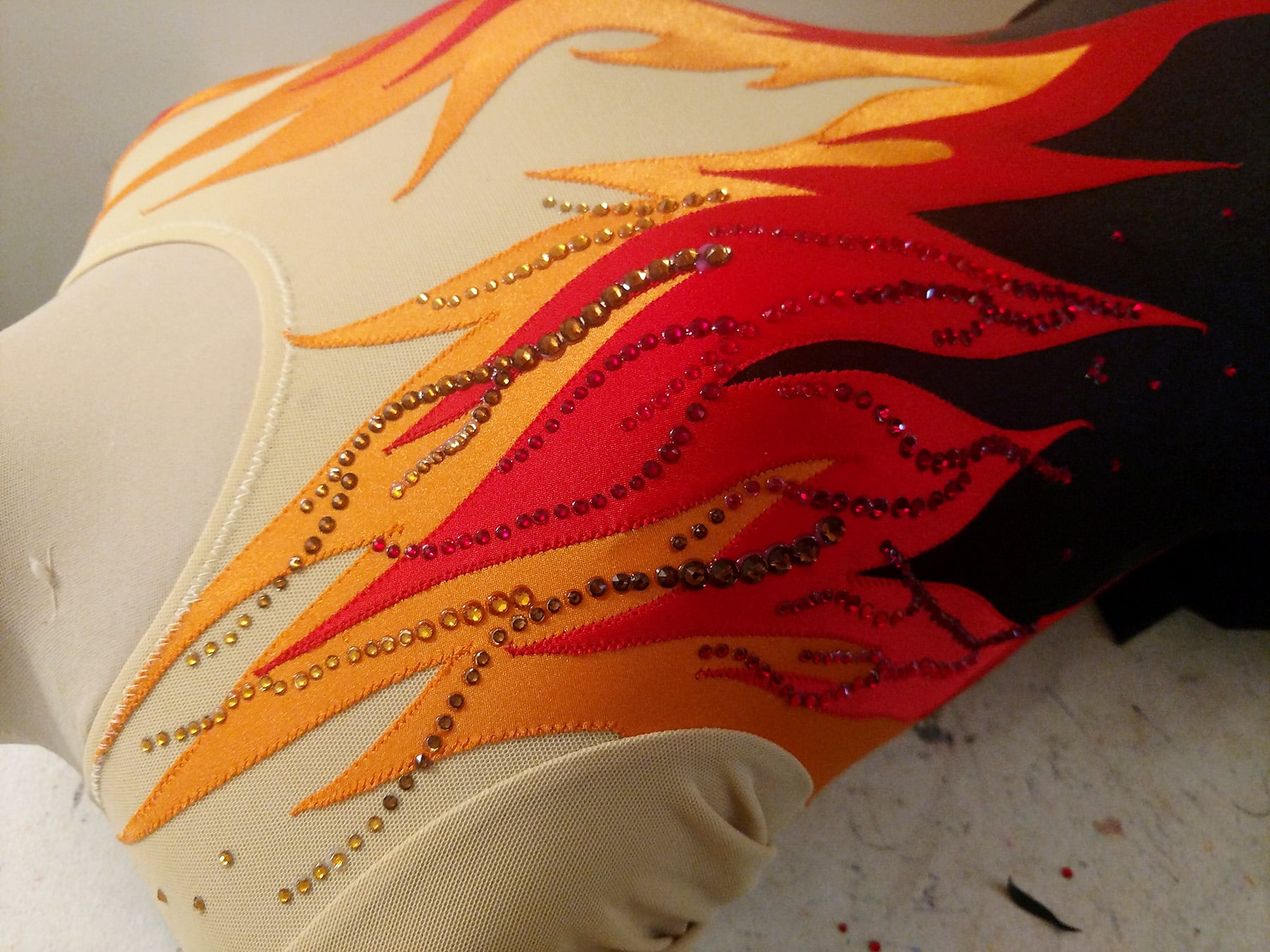
I use E-6000 Fabri-Fuse for crystalling on spandex.
It doesn’t stink and doesn’t cause headaches. I don’t notice fumes from it, either.
As a bonus, the bottle makes it SUPER easy to use, it holds as well as normal E-6000, dries clear, and is just great all around.
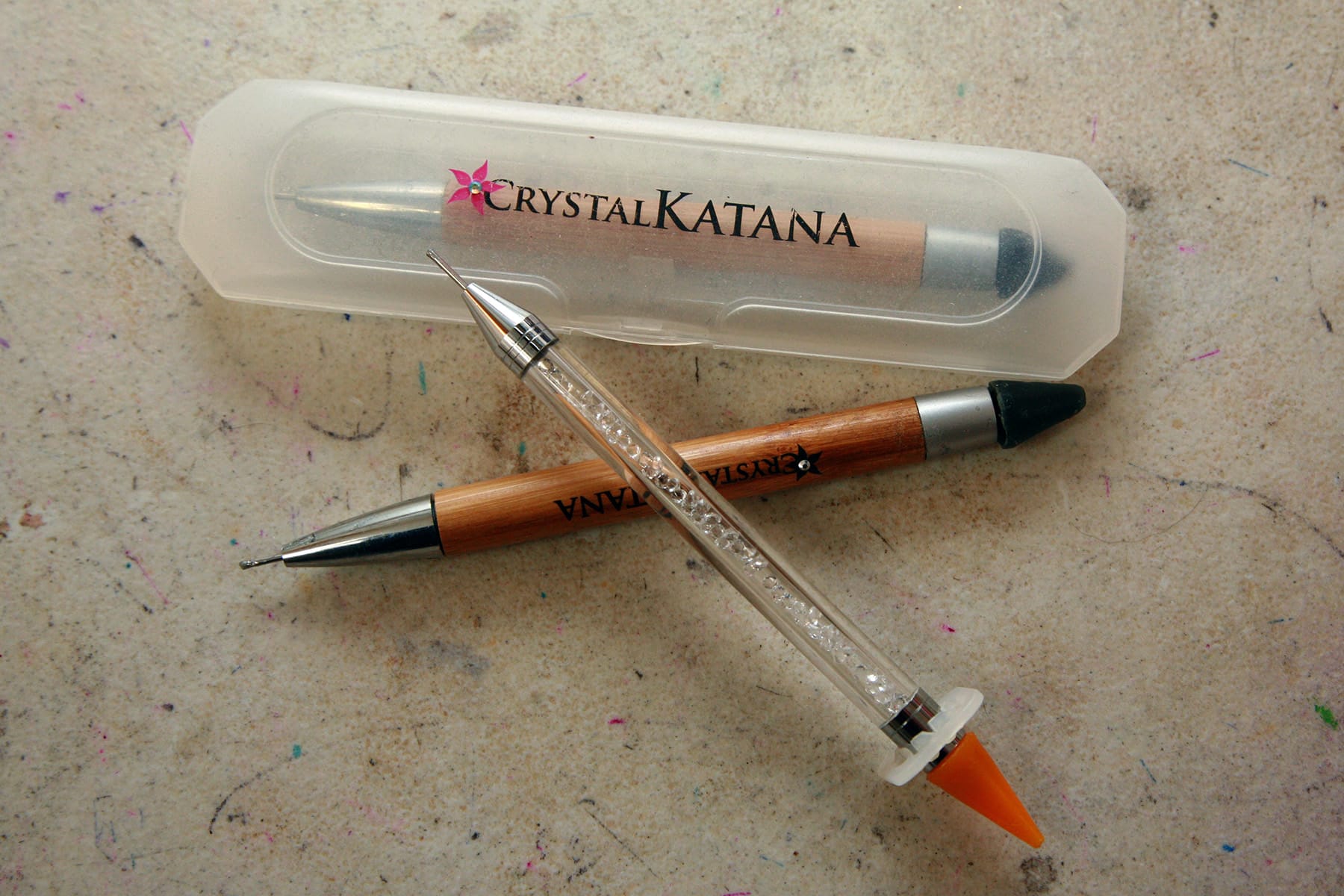
In addition to the E-6000 Fabri-Fuse, I use a Crystal Katana for picking up and positioning the stones.
These kind of wax tools - Rhinestone Pickers - are made by a few companies.
Crystal Katana can be hard to come by, locally, so I do have one from another brand, as well.

Anyway, I let it sit for a few days after crystalling, just to be sure the glue is good and cured. Overkill, I know.
The finished dress:

More Figure Skating Sewing Tutorials
Want some more skating related sewing content? Try these on for size:
Basic Skating Dress Tutorial
How to Hem Spandex
Bodyshirts for Male Figure Skaters
How to Draft Skating Skirt Patterns
Pull-on Figure Skating Skirts
How I Made That: 80's Figure Skating Dress
How I Made That: The Pink & Black Skating Dress
How to Make Scrunchies
How to Pattern and Make Waterfall Skirts
How to Make Skate Covers
How to Make Soakers
Proper Care of Figure Skating Dresses
How I Made That: Art Deco Skating Dress
How I Made That: The Ursula Dress
Share the Love!
Be sure to take some pics of your handiwork! If you post it to Bluesky, be sure to tag us - @SpandexSimplified.
Also, be sure to follow me on Pinterest, and subscribe to my Youtube Channel, so you never miss out on any of my nonsense.
Well, the published nonsense, anyway!
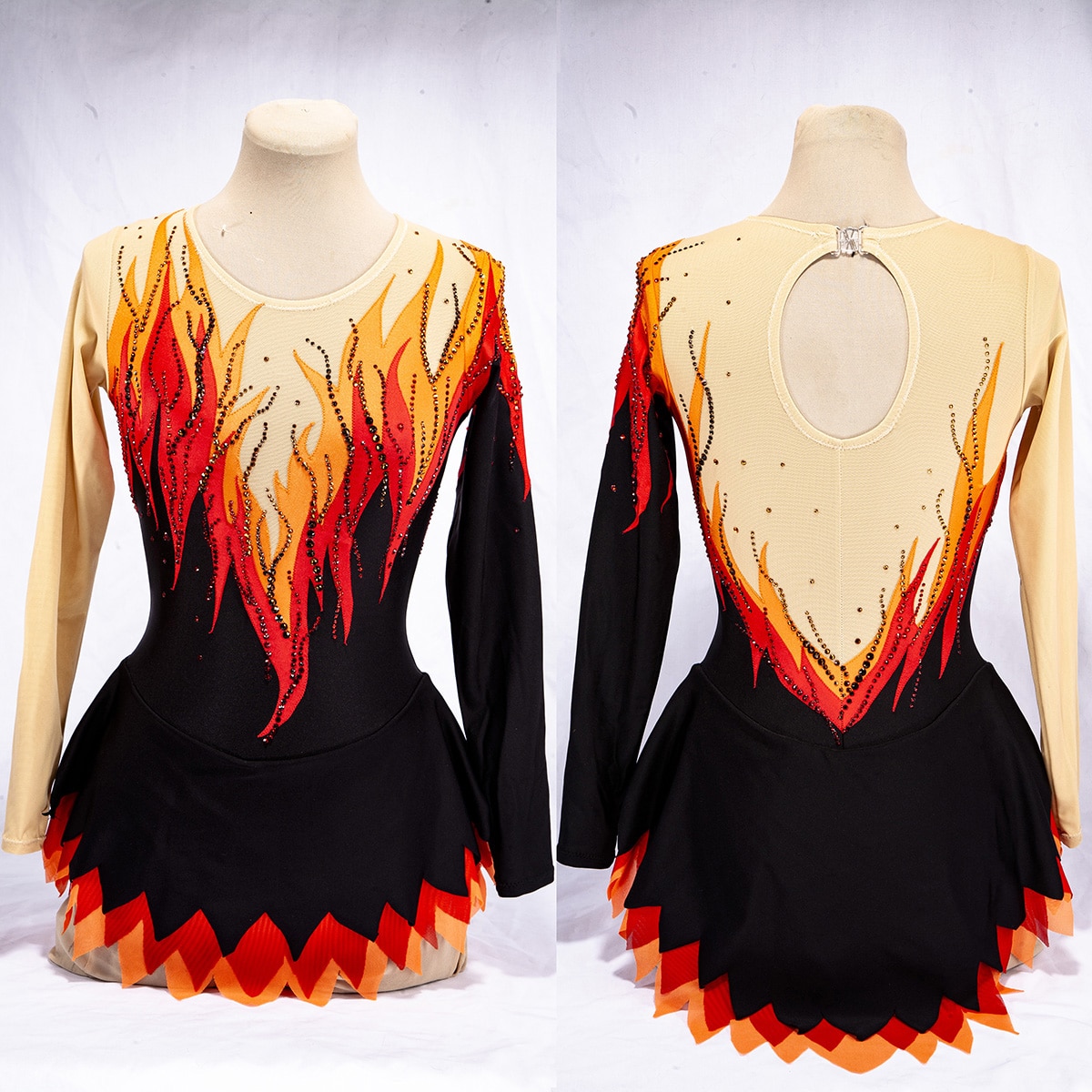
So, what do you think? Should I post more of these "How I Made That" kind of posts? Comment below with your thoughts!


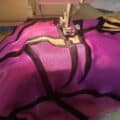

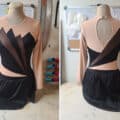
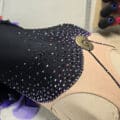
Hi, I'm in love with this dress design. Me and my freedance partner want to skate to a song related with fire and I'm looking for costume designer. I am not sure if you retired or just do it for the fun of it. But if you do, do it for like customers can you let me know! I love your work!
Is this ice skating dress for sale?
It's not, but I can always make another as a commission!
Love everything you shared here! I am about to make a similar dress for my daughter. I am not sure if I should choose the shiny version of the spandex or the matte version in order to match the mesh skirt if they are the same color, such as crimson. Will there be some slight color differences between shiny, matte and mesh if I choose the same color?
Thank you so much!
Well mesh tends to be more matte, so - all other things being equal - will match the spandex better than shiny.
That said, definitely go for whichever has the overall effect you're looking for!
For bright colours and high contrast like this dress, personally? I prefer shiny. It looks more vibrant.
You are the best, Marie! Thank you!